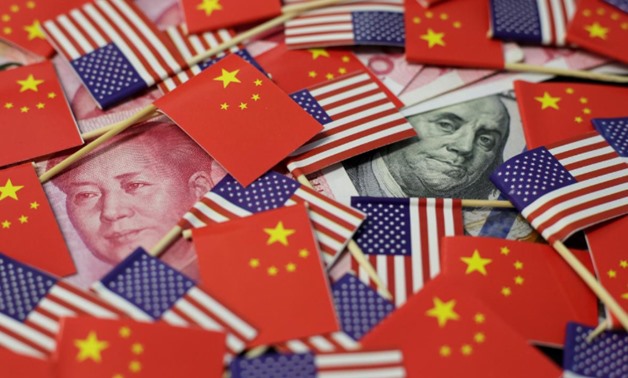
A U.S. dollar banknote featuring American founding father Benjamin Franklin and a China's yuan banknote featuring late Chinese chairman Mao Zedong are seen among U.S. and Chinese flags in this illustration picture taken May 20, 2019. REUTERS/Jason Lee/Ill
LONDON 5 August 2019: Global stocks fell for a sixth day on Monday as an escalation of trade tensions between the United States and China spooked markets and the yuan fell to its lowest levels in over a decade.
Safe-haven assets including the Japanese yen, core government bonds and gold rallied.
European shares fell to two-month lows, with the pan-European STOXX 600 index shedding 2% on top of the 2.5% it lost on Friday - its worst day so far in 2019 - after U.S. President Donald Trump signaled another round of tariffs on Chinese imports.
“Markets had not been expecting the latest US-China trade talks to conclude with any significant breakthrough last week, but very few expected President Trump to slap 10% tariffs on $300 billion worth of Chinese goods,” said Hussein Sayed, chief market strategist at FXTM.
MSCI’s All Country World Index, which tracks shares in 47 countries, was down 0.7% on the day. That put it down almost 2% including Friday’s loss.
Asian shares suffered their steepest daily drop in 10 months, with MSCI’s broadest index of Asia-Pacific shares outside Japan sinking 2.5% to depths not seen since late January.
The VIX .VIX volatility index - also known as Wall Street’s “fear gauge” - rose to 19.02%, its highest since May 13, while Europe’s equivalent .V2TX hit its highest since early January.
S&P 500 futures ESc1 were 1.35% lower.
“We reiterate our view to scale back equity positions to strategic allocations after strong gains year to date, amid the ongoing trade-related uncertainties,” Credit Suisse analysts wrote in a note to clients.
The biggest mover in currencies was the yuan, which fell past the key level of 7 to the dollar as Chinese authorities - expected to defend the currency at that level - allowed it to break through to its lowest in the onshore market since the 2008 global financial crisis.
In offshore markets, the yuan CNH=EBS fell to its weakest since international trading of the Chinese currency began. Headed for its biggest one-day drop in four years, it was last down 1.4% at 7.0744 in offshore markets.
“Over the past couple of years, China has kept the renminbi stable against the basket, but with the renminbi TWI (trade-weighted index) now testing the lower end of the range in play since 2017, investors may turn nervous, introducing another dose of volatility,” Morgan Stanley strategists wrote in a note to clients.
The currencies of other Asian economies closely linked with China’s growth prospects also dropped.
The Korean won KRW= fell 1.4% against the dollar, on course for its biggest one-day loss since August 2016. The new Taiwan dollar fell more than 0.7% TWD=.
BID FOR SAFETY
Japan's yen, which investors tend to buy in times of risk aversion, rose 0.7% to its highest since a January flash crash. JPY=
Dutch 30-year government bond yields turned negative for the first time as euro zone yields sank further amid concerns about U.S.-China trade and a no-deal Brexit.
U.S. 10-year yields dived 7 basis points to 1.77%, while Germany’s 10-year bund yields fell to -0.53%. The three-month to 10-year U.S. yield curve was at its most inverted in 11 years.
The Swiss franc CHF= was also boosted by safe-haven demand. Trump is also eyeing tariffs on the European Union, but has yet to make a formal announcement. The euro EUR= was 0.3% higher to the dollar at $1.1137.
Sterling GBP= hovered near 2017 lows at $1.2117, pressured by concerns about Britain exiting the EU without a trade deal in place.
Oil extended losses with U.S crude down 1.55% at $54.8 and Brent down 1.55% at $60.92.
Gold prices jumped more than 1% to their highest in more than six years, with spot gold prices up 1.1% to $1,456.51 per ounce.


Comments
Leave a Comment